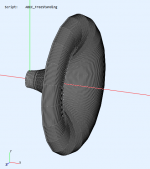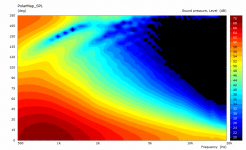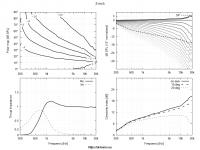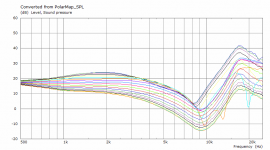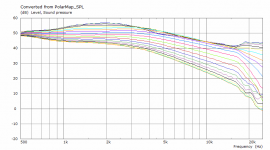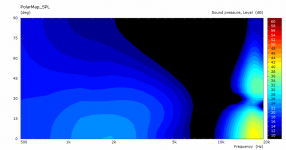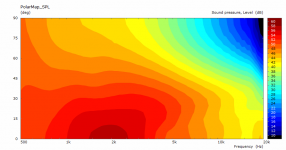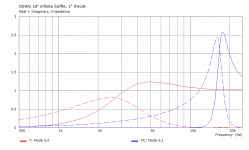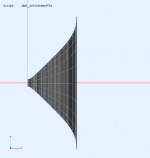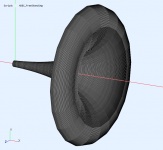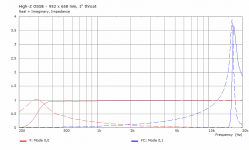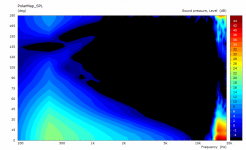You can also play with such things directly in Ath - that's exactly what the source definition script can be used for.
I found an article that demonstrates a 0,1 mode converted back to 0,0 mode #033: Evanescent Acoustic Waves in Tubes
I don't understand much yet so might not relate to the subject at hand.
I don't understand much yet so might not relate to the subject at hand.
So maybe the graphs
(this: https://www.diyaudio.com/forums/att...2753495-acoustic-horn-design-easy-ath4-20-png)
should not only contain mode 0 but also the 1st and 2nd in order to represent better reality?
//
(this: https://www.diyaudio.com/forums/att...2753495-acoustic-horn-design-easy-ath4-20-png)
should not only contain mode 0 but also the 1st and 2nd in order to represent better reality?
//
The reality depends on what is the actual shape of the input wavefront (as a function of frequency). We still don't know that.
Finally, the standard report -2" throat, ⌀496 x 198 mm. Modes 0,0 - 0,1 - 0,2. Nothing surprising.
Attachments
2"... is the above what i would get out using a Acoustic Horn Design – The Easy Way (Ath4) post #4348 or a https://sbacoustics.com/product/2½in-sb65wbac25-4/
//
//
I have another one - 18" OSWG, 1" throat, infinite baffle, modes 0,0 and 0,1.
Attachments
Mabat, one uber-noob question.
I assume that If the waveguide/horn is going to be in a standard speaker baffle, the correct modelling is "FREE AIR", correct?
The responses modelled in FREE AIR vs INFINITE BAFFLE is quite different and more jagged.
I assume that If the waveguide/horn is going to be in a standard speaker baffle, the correct modelling is "FREE AIR", correct?
The responses modelled in FREE AIR vs INFINITE BAFFLE is quite different and more jagged.
The question is - now what?
Well we have learned, but it was of course already anticipated, that wider throats yield lower cut-ins of the diaphragm modes. For a 1" throat all the modes are high enough that we could likely ignore them. For a 2" they will pose a significant limitation on the HF response, most likely causing the need for another driver to handle this frequency region. To me, the take-away is that for home HF one should limit themselves to a 1" driver.
As to the effect that these modes will have on the response, I should make clear that many things can happen - it all depends on the phase of the HOM relative to the normal mode. One phase adds and the directivity will narrow and the opposite phase will substract, creating a possible hole, and anything in-between is possible. Hence, the driver specifics will determine the response once the HOM kick in and will differ from driver to driver. Below that, the HOM will have little to no effect on the drivers allowing only the planar mode to propagate.
These are all useful new knowledge, although neither surprising nor unanticipated, but still Mabat has shown that they are real and can have a significant effect on the results.
One could take these results and highly accurate polar results (not trivial to do at these very high frequencies) to calculate back to the throat and find out what the throat motion was. For 1" drivers this is likely a waste of time, but for 2" ones it would be feasible to do and likely very instructive.
... To me, the take-away is that for home HF one should limit themselves to a 1" driver. ....
Duly noted - thanks!!
//
The more suitable at the moment is the infinite baffle because in Ath there's still no option to put a waveguide into a box and simulate the whole in free air (not implemented yet).I assume that If the waveguide/horn is going to be in a standard speaker baffle, the correct modelling is "FREE AIR", correct?
It doesn't have to be that way. Actually, I believe that a free standing waveguide can be made smoother (see almost all the previous examples) but to confirm this I'll have to implement the box option.The responses modelled in FREE AIR vs INFINITE BAFFLE is quite different and more jagged.
I don't have any LeCleach profile at hand, only something similar (high-z OSSE ⌀952 x 658 mm, 1" throat) -Has anyone looked at some if the Lecleach profiles regarding the modes?
Attachments
Last edited:
im sorry if im late to the event here but i just found this post after getting a 3d printer and though it would be great to design a hf horn and use the printer to make it.
im having trouble getting this to work correctly, and ill admit i need a Ath for dummies post to get it working.
i have gnuplot,abec,360 and meshmixer all installed and they seem to work as expected on their own.
i also have the dll file extracted into the ath folder, and the text file in the ath folder with the following OutputRootDir = "C:\Users\helix\Desktop\ATH"
MeshCmd = "C:\Users\helix\Desktop\ATH\gmsh-4.8.4-Windows64\gmsh-4.8.4-Windows64\gmsh.exe %f -"
GnuplotPath = "C:\Program Files\gnuplot\bin\gnuplot"
I have the shortcut created and it starts in ath 4.7.0 but I'm not entirely sure what to do from here, or if im even doing it right.
im having trouble getting this to work correctly, and ill admit i need a Ath for dummies post to get it working.
i have gnuplot,abec,360 and meshmixer all installed and they seem to work as expected on their own.
i also have the dll file extracted into the ath folder, and the text file in the ath folder with the following OutputRootDir = "C:\Users\helix\Desktop\ATH"
MeshCmd = "C:\Users\helix\Desktop\ATH\gmsh-4.8.4-Windows64\gmsh-4.8.4-Windows64\gmsh.exe %f -"
GnuplotPath = "C:\Program Files\gnuplot\bin\gnuplot"
I have the shortcut created and it starts in ath 4.7.0 but I'm not entirely sure what to do from here, or if im even doing it right.
Has the Rot parameter been mentioned before? I don't remember having seen it described.Ath script attached.
If the guide is axisymmetric and simulated with circsym they will be more similar but if a full 3D mesh is simulated other parameters such as where and how the interface is created can have a big impact on the simulated response, more so if a rollback is used.The responses modelled in FREE AIR vs INFINITE BAFFLE is quite different and more jagged.
I don't have any LeCleach profile at hand, only something similar (high-z OSSE ⌀952 x 658 mm, 1" throat) -
Looks bit more wilder this one. Can you test some other waveguide profiles as well? The first results you posted might be smoothest already?
Straight sided conical? how about small step/angle mismatch at the horn throat? some random device from the simulation runs you posted few days ago? Does mouth rollback have any effect?
Last edited:
- Home
- Loudspeakers
- Multi-Way
- Acoustic Horn Design – The Easy Way (Ath4)
